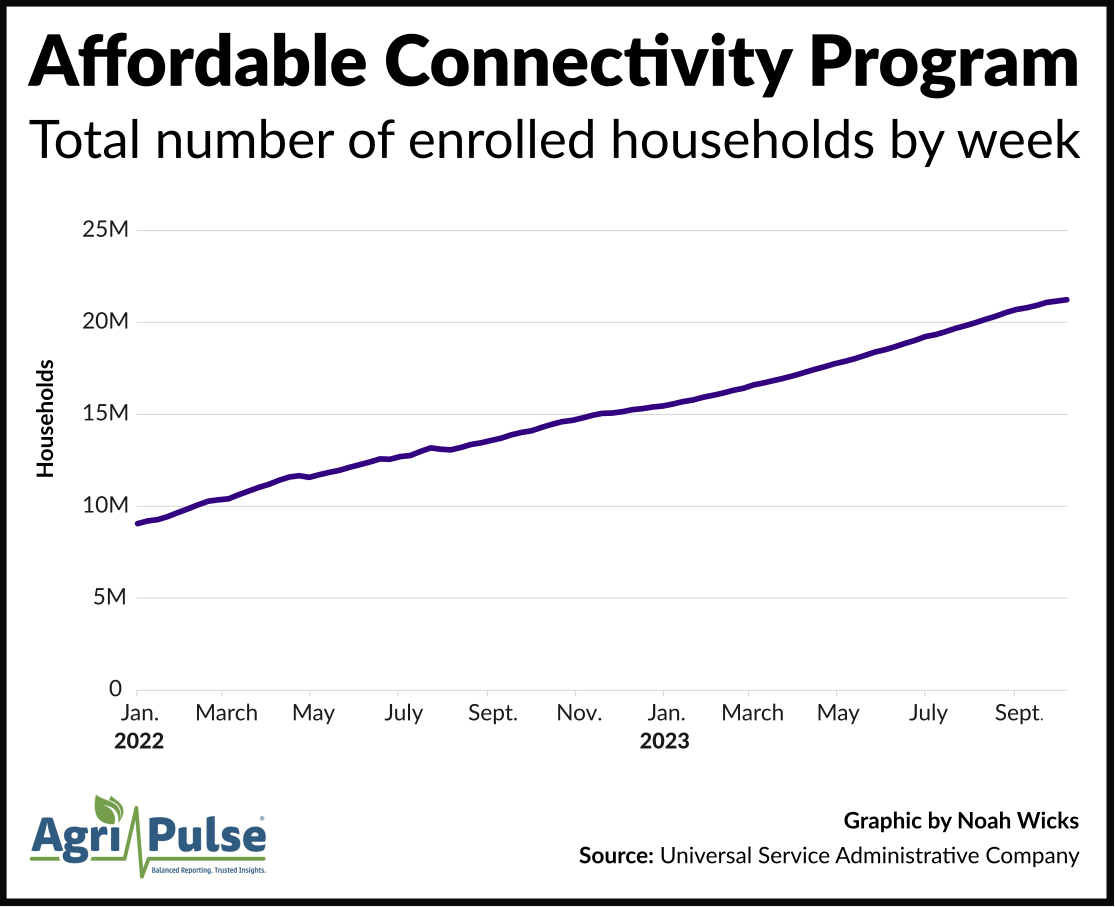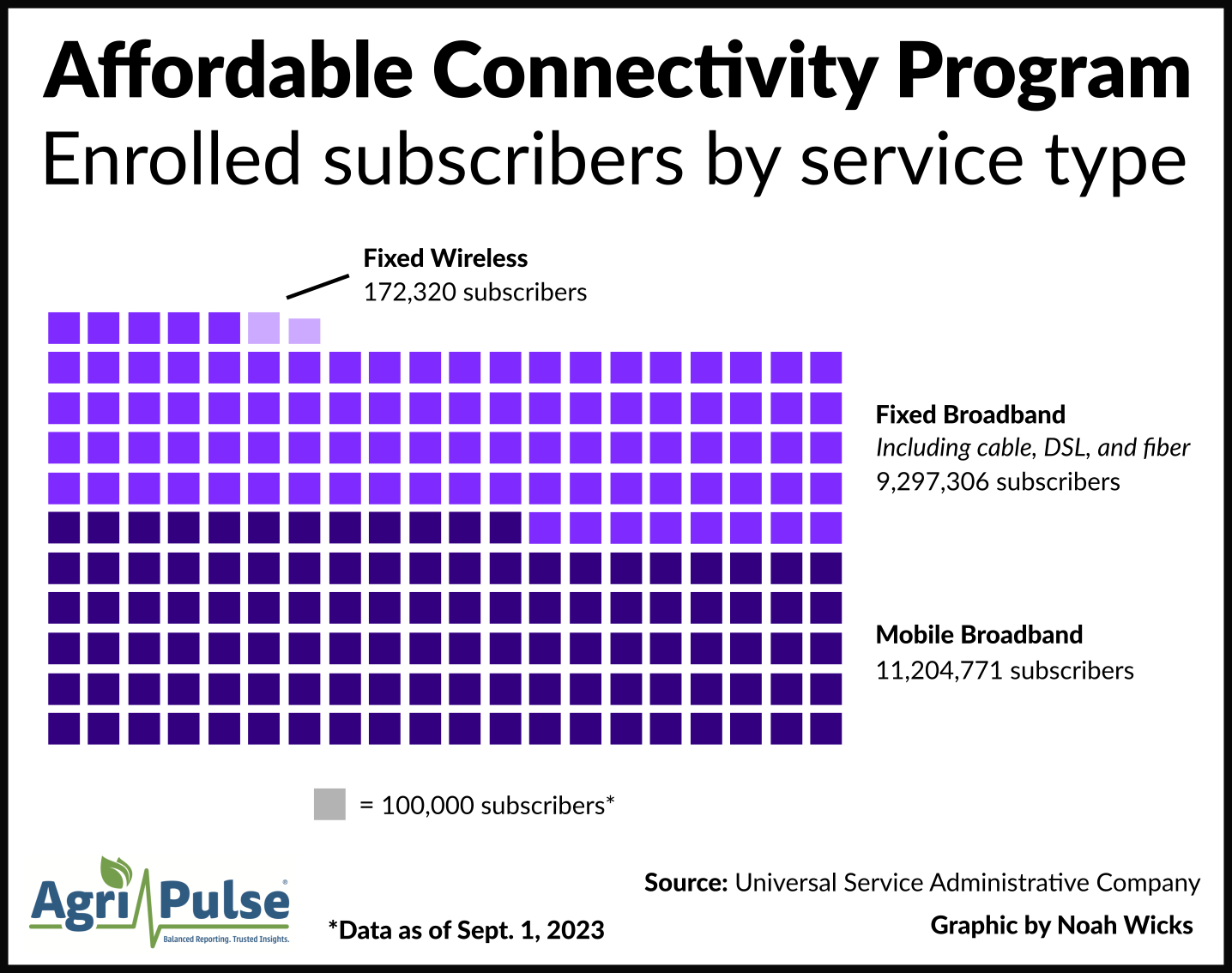Groups and lawmakers from both sides of the political aisle are working to save a popular broadband affordability program before it runs out of funding.
The Affordable Connectivity Program, launched in 2022 as part of the Infrastructure Investment and Jobs Act, provides $30 per month that some households can put towards their internet bills, as well as a one-time $100 subsidy to buy computers. Households in certain rural and tribal areas receive up to $75 per month for their internet bills.
 Approximately 21 million households had enrolled in the program as of Oct. 9, according to data from the Universal Service Administrative Company, which operates under the direction of the FCC. More than 11 million ACP enrollees used the program to subscribe to mobile broadband services, while around 9 million used it for cable, DSL, fiber and other fixed broadband services. Approximately 172,000 used it for fixed wireless services.
Approximately 21 million households had enrolled in the program as of Oct. 9, according to data from the Universal Service Administrative Company, which operates under the direction of the FCC. More than 11 million ACP enrollees used the program to subscribe to mobile broadband services, while around 9 million used it for cable, DSL, fiber and other fixed broadband services. Approximately 172,000 used it for fixed wireless services.
Funding for the program has quickly been depleted due to its popularity, however.
“It’s to some degree a victim of its own success,” Mike Romano, the executive vice president of NTCA – The Rural Broadband Association, told Agri-Pulse. “The more people it helps to get online, the faster the money potentially runs out.”
Some $6 billion remains from the $17 billion appropriated for the program and its predecessor, the Emergency Broadband Benefit Program, according to USAC. But these funds could be depleted as early as April, according to testimony earlier this year from Federal Communications Commission Chair Jessica Rosenworcel.
In a June hearing, Rosenworcel warned lawmakers that the agency would begin looking at ways to “wind down” the program this fall unless Congress extends it with more funding. Letting the program cease, she said, would “cut families off.”
“If Congress were to fail to appropriate new funds for the Affordable Connectivity Program, we would undermine the biggest broadband affordability program this nation has ever created,” Rosenworcel said.
Romano said the program’s looming end has also left broadband providers with lingering questions about how to handle the customers who cannot maintain their internet subscriptions without the program’s support. One of the major ones, he said, is how soon providers will need to warn customers of the program’s end.
Romano said around 80% of NTCA’s members participate in the program.
Several groups have called on Congress to step in to prevent the program from ending. Members of the U.S. Cattlemen's Association, the National Grange, the Rural and Agriculture Council of America and RuralRISE Tech said in a letter to congressional leaders last month that the digital divide “is just as much of an affordability issue as it is an access issue.”
 The groups, in their letter, said 18 of the 28 million households in the U.S. lacking broadband internet in their homes “say it is simply because they cannot afford an internet connection.” Hard-to-reach areas also tend to have higher costs due to the challenges of broadband deployment in these regions, they said.
The groups, in their letter, said 18 of the 28 million households in the U.S. lacking broadband internet in their homes “say it is simply because they cannot afford an internet connection.” Hard-to-reach areas also tend to have higher costs due to the challenges of broadband deployment in these regions, they said.
Burton Eller, legislative director for the National Grange, said people in rural areas increasingly need the internet to do homework, pay bills, and use telehealth services. He said his daughter, who is currently paying off her student loans, isn’t given an option to do so via check; she uses the internet instead.
“Paper, as much as we love it and as much as we older generations are used to it and comfortable with it, is slowly going out of the picture,” Eller said.
Eller said the program has helped people with internet affordability, one major hurdle to internet access in rural places. But the looming threat of the ACP’s end could leave low-income rural residents facing the same challenge they were before it came into place.
“You’ll catch a lot of folks that have just signed up and the money runs out and they’re left there holding the bag,” Eller said. “They’re no better off than they were before the ACP program.”
A bipartisan group of 45 House members said in a letter earlier this year that letting the ACP run out of funds would “not only put the program’s success at risk, but also impede the progress of other federal broadband investments and initiatives.” The lawmakers said the program should be extended in this year’s annual appropriations bill.
It’s easy to be “in the know” about what’s happening in Washington, D.C. Sign up for a FREE month of Agri-Pulse news! Simply click here.
Members of the Rural Broadband Caucus also called for Congress to pass an extension, saying in a letter that the “continuation of the ACP will improve the economic case for deployment and reaffirm our continued commitment to provide broadband service to millions of unserved and undersold households.”
“We urge you to support funding for the Affordable Connectivity Program as we explore new funding mechanisms to remove this program from the traditional appropriations process,” they said.
One of the alternate funding avenues lawmakers are exploring is the Universal Service Fund, a fund made up of money collected from telecommunications companies to be used for four communications programs. One of these programs, Lifeline, shares several similarities with ACP, but has historically been funded at a lower rate, Romano said.
Romano said it’s possible for the lawmakers to make the USF the funding source for the ACP, rather than relying on appropriations to keep the program alive. The fund, however, is based on assessments of “legacy telecommunication services that customers are buying less and less of over time,” Romano said.
Romano said a reform of the USF, something lawmakers have been talking about for years, would likely be needed to effectively support ACP. While bills to do so have been introduced in the past, Romano said efforts to restructure the USF have gotten “tied up in political knots.”
Romano said whether Congress will be able to move ACP within the USF is a question of “political will.”
“It’s an odd place where there seems to be such widespread support for something, but it’s so hard to make it happen,” Romano said.
For more news, go to www.agri-pulse.com.


